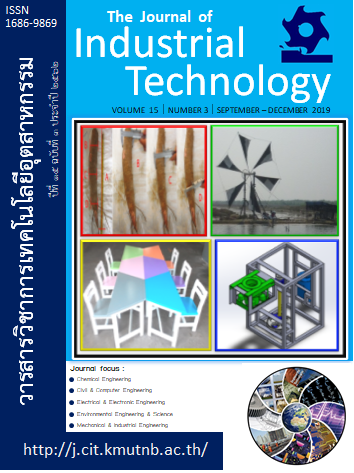(ทฤษฎีเบลดเอลิเมนท์โมเมนตัมเพื่อการประเมินประสิทธิภาพ กังหันลมเสื่อลำแพน)
คำสำคัญ:
ทฤษฎีเบลดเอลิเมนท์โมเมนตัม, การจำลองกังหันลมเสื่อลำแพน, ประสิทธิภาพกังหันลม, การสอบเทียบบทคัดย่อ
บทคัดย่อ
กังหันลมเสื่อลำแพนเป็นเครื่องจักรกลท้องถิ่นของประเทศไทย ปัจจุบันใช้ในการสูบน้ำเข้านาเกลือ เป็นกังหันลมแกนนอนที่มีลักษณะใบเป็นรูปสามเหลี่ยมทำจากผ้าใบ กังหันลมเสื่อลำแพนแบบดั้งเดิมจะมีประสิทธิภาพประมาณ 10-17% แต่ปัจจุบันได้มีการพัฒนาจนสามารถเพิ่มประสิทธิภาพได้สูงขึ้นถึง 30-35% ดังนั้นจากต้นทุนการสร้างที่ค่อนข้างต่ำ โครงสร้างเรียบง่าย และประสิทธิภาพที่สูงขึ้น ทำให้กังหันลมเสื่อลำแพน มีความน่าสนใจต่อการทำวิจัยมากขึ้น อนึ่งงานวิจัยประเภทการจำลอง (Simulation) ก็นับเป็นหัวข้อหนึ่งที่มีความสำคัญ เพราะว่าการจำลองที่แม่นยำจะนำไปสู่การประเมินค่าแรงบิด กำลัง และประสิทธิภาพในสภาวะอื่น ๆได้อย่างถูกต้องโดยไม่ต้องพึ่งการทดลอง ซึ่งจะมีประโยชน์อย่างมากต่อการออกแบบใบกังหันลม วัตถุประสงค์ของบทความนี้คือ สร้างแบบจำลองกังหันลมเสื่อลำแพนโดยใช้พื้นฐานทฤษฎีเบลดเอลิเมนท์โมเมนตัม เพื่อประเมินประสิทธิภาพและสอบเทียบกับผลการทดลอง การประเมินประสิทธิภาพจะพิจารณาที่มุมพิตช์ปลายใบ 4 ลักษณะ คือ 5, 10, 15 และ 20 องศา ผลลัพธ์ที่ได้คือ ประสิทธิภาพกังหันลมเสื่อลำแพนที่ประเมินด้วยแบบจำลองมีความแม่นยำ ที่มุมพิตช์ปลายใบเท่ากับ 10, 15 และ 20 องศา ในช่วงอัตราส่วนความเร็วปลายใบ 2.0-3.5 โดยมีความคลาดเคลื่อนเฉลี่ยเท่ากับ 7.0%
เอกสารอ้างอิง
[1] P. Mukhia, “Performance and Aerodynamic Analysis of The Thai Four Bladed Wooden Rotor Coupled to A Ladder Pump”, Master Thesis, Asian Institute of Technology, Thailand. 1981.
[2] R. Thepwong, “Design Improvements of Thai Sail Windmill for Water Pumping”, Ph.D Thesis, School of Civil Engineering, Rajamangala University of Technology Rattanakosin. 2013.
[3] T. Klabklay, “Efficiency Enhancement and Cost Reduction of Thai Sail Windmill”, Ph.D. Thesis, School of Mechanical Engineering, Suranaree University of Technology. 2016. (in Thai)
[4] L. Wang, R. Quant and A. Kolios, “Fluid Structure Interaction Modelling of Horizontal-Axis Wind Turbine Blades Based on CFD and FEA”, Journal of Wind Engineering and Industrial Aerodynamics 158, 2016, pp. 11-25.
[5] J.P. Monteiro, M.R. Silvestre, H. Piggott and J. André, “Wind Tunnel Testing of A Horizontal Axis Wind Turbine Rotor and Comparison with Simulations From Two Blade Element Momentum Codes”, Journal of Wind Engineering and Industrial Aerodynamics 123, 2013, pp. 99-106.
[6] J.L. Tangler, and J.D. Kocurek, “Wind Turbine Post-Stall Airfoil Performance Characteristics Guidelines for Blade-element Momentum Methods”, Technical Report NREL/CP-500-36900. National Renewable Energy Laboratory, Colorado. 2005.
[7] T. Klabklay and T. Chitsomboon, “Prediction of Thai Sail Windmill Performance by a Blade Element Momentum Theory”, The 29th Conference of Mechanical Engineering Network of Thailand, 2015, pp. 713-717 (in Thai)
[8] P. Pratumnopharat and P.S. Leung, “Validation of Various Windmill Brake State Models Used by Blade Element Momentum Calculation”, Renewable energy 36, 2011, pp. 3222-3227.
[9] J.F. Manwell et al., “Wind energy explained” (2nd ed.)”, John Wiley & Son, 2009.
[10] Ch. Thumthae, “Accurate CFD Procedures for The Validation of The Theoretical Design of Wind Turbine”, Ph.D. Thesis, School of Mechanical Engineering, Suranaree University of Technology. 2009. (in Thai)
[11] L. Prandtl and A. Betz, “Vier Abhandlungen zur Hydrodynamik und Aerodynamik”, Göttinger Nachr, Göttingen, 1927, pp. 88–92.
[12] J.L. Buhl, “A New Empirical Relationship between Thrust Coefficient and Induction Factor for The Turbulent Windmill State”, Technical report NREL/TP-500-36834. NREL, Colorado. 2005.
[13] A.D. Spera, “Wind Turbine Technology: Fundamental Concepts of Wind Turbine Engineering (2nd ed.)”, ASME Press, 1998.
[14] R. Lanzafame, S. Mauro and M. Messina, “HAWT Design and Performance Evaluation: Improving the BEM Theory Mathematical Models”, Energy Procedia 82, 2015, pp. 172-179.


